ORION—Art Collections and Collectors in Portugal
Abstract
:1. Introduction
2. Materials and Methods
3. Results
Francis Cook Collection as a Case Study
4. Discussion
5. Conclusions
Author Contributions
Funding
Conflicts of Interest
References
- Berg-Fulton, T.; Langmead, A.; Lombardi, T.; Newbury, D.; Nygren, C. A Role-Based Model for Successful Collaboration in Digital Art History. Int. J. Digit. Art Hist. 2018, 152–180. [Google Scholar] [CrossRef]
- Baca, M.; Harpring, P. (Eds.) Categories for the Description of Works of Art; J. Paul Getty Trust; College Art Association: New York, NY, USA, 2014; Available online: http://www.getty.edu/research/publications/electronic_publications/cdwa/index.html (accessed on 22 December 2018).
- Yeide, N.; Akinsha, K.; Walsh, A.L. The AAM Guide to Provenance Research; American Association of Museus: Washington, DC, USA, 2001. [Google Scholar]
- Feigenbaum, G.; Reist, I. Provenance: An Alternate History of Art; Getty Research Institute: Los Angeles, CA, USA, 2012. [Google Scholar]
- Fuhrmeister, C.; Hopp, M. Rethinking Provenance Research. Getty Res. J. 2019, 11, 213–231. [Google Scholar] [CrossRef]
- Neto, M.J. Coleccionadores e Connaisseurs de obras de arte: Francis Cook (1817-1901) e John Charles Robinson (1824–1913) em Portugal. Artis, Revista do Instituto de História da Arte da Faculdade de Letras de Lisboa 2007, 1, 403–442. [Google Scholar]
- Neto, M.J. (Ed.) ARTIS—Revista de História da Arte e Ciências do Património, 2014; 2.
- Neto, M.J.; Malta, M. (Eds.) Coleções de Arte em Portugal e Brasil nos séculos XIX e XX: Perfis e trânsitos; Caleidoscópio: Lisboa, Portugal, 2014. [Google Scholar]
- Neto, M.J. Monserrate. A casa romântica de uma família inglesa; Caleidoscópio: Lisboa, Portugal, 2015. [Google Scholar]
- Neto, M.J.; Malta, M. (Eds.) Coleções de Arte em Portugal e Brasil nos séculos XIX e XX. As Academias de Belas-Artes. Rio de Janeiro, Lisboa, Porto (1816–1836). Ensino, artistas, mecenas, colecções; Caleidoscópio: Lisboa, Portugal, 2016. [Google Scholar]
- Soares, C.M. A Coleção de arte do Conde do Ameal: O leilão de 1921 e as aquisições do Estado Português para os Museus Nacionais. In Anais do II Colóquio Internacional Coleções de Arte em Portugal e no Brasil nos Séculos XIX e XX. Modos de ver e exibir em Brasil e Portugal; Neto, M.J., Malta, M., Cavalcanti, A., Oliveira, E.D., Couto, M.F.M., Eds.; Rio Books/EBA/UFRJ: Rio de Janeiro, Brazil, 2016; pp. 89–105. ISBN 978-85-94970-07-7. [Google Scholar]
- Neto, M.J. (Ed.) Monserrate Revisitado. A Colecção Cook em Portugal; Caleidoscópio: Lisboa, Portugal, 2017. [Google Scholar]
- Mariz, V. From Portugal to England. John Charles Robinson’s purchases in the Portuguese art market. J. Hist. Collect. 2018, fhy057. [Google Scholar] [CrossRef]
- Rodrigues, R. Entre a salvaguarda e a destruição: A extinção das ordens religiosas em Portugal e as suas consequências para o património artístico dos conventos (1834–1868). Ph.D. Thesis, Faculdade de Letras da Universidade de Lisboa, Lisboa, Portugal, 2017. Available online: http://hdl.handle.net/10451/29993 (accessed on 6 March 2019).
- Soares, C.M. A extinção das ordens religiosas em Portugal na implantação do Liberalismo: Efeitos sobre o património artístico dos conventos. In De Viollet-leDuc a la Carta de Venecia. Teoría y Práctica de la Restauración en el espacio Iberoamericano; LNEC: Lisboa, Portugal, 2014; pp. 9–16. [Google Scholar]
- Other provenance projects are the Kress Provenance Research Project, developed by the Samuel H. Kress Foundation, the Frits Lugt, Collectors’ Marks on Prints and Drawings (Fondation Custodia), relevant to the field, as well as the projects directly related with the WW2 as the Art Provenance World War II Research, developed by the Smithsonian Museums.
- Jaskot, P.B. Debates in the Digital Humanities, edited by Matthew K. Gold. Vis. Resour. 2013, 29, 135–140. [Google Scholar] [CrossRef]
- Matos, A. SPECTRUM: Uma norma de gestão de coleções para os museus portugueses. Ph.D. Thesis, Faculdade de Letras da Universidade do Porto, Porto, Portugal, 2012. Available online: http://repositorio-aberto.up.pt/handle/10216/67304 (accessed on 22 December 2018).
- Baca, M.; Harpring, P.; Lanzi, E.; McRae, L.; Whiteside, A. Cataloging Cultural Objects: A Guide to Describing Cultural Works and Their Images; American Library Association: Chicago, IL, USA, 2006. [Google Scholar]
- Cobb, J. The Journey to Linked Open Data: The Getty Vocabularies. J. Libr. Metadata 2015, 15, 142–156. [Google Scholar] [CrossRef]
- Harpring, P. Introduction to Controlled Vocabularies Terminology for Art, Architecture, and Other Cultural Works; Getty Research Institute: Los Angeles, CA, USA, 2013. [Google Scholar]
- Jorge, N. Ensaio sobre o AAT-Art & Architecture Thesaurus: Proposta terminológica de adaptação à realidade portuguesa. Master’s Thesis, Faculdade de Letras da Universidade do Porto, Porto, Portugal, 2011. Available online: http://repositorio-aberto.up.pt/handle/10216/57042 (accessed on 22 December 2018).
- Az Infinitum—Azulejo Indexation and Referencing System. Is a Research-Oriented Project Also Based on a Relational Database Aiming to Document the Portuguese Azulejos (Tiles) Still Found In Situ. Az Infinitum Is Divided into Five Main Areas, Which Are Interconnected and Provide a Comprehensive Understanding of Each Tile Decoration. Available online: http://redeazulejo.letras.ulisboa.pt/pesquisa-az (accessed on 1 January 2019).
- Danziger, E. The Cook Collection, its founder and its inheritors. Burlingt. Mag. 2004, CXLVI, 444–458. [Google Scholar]
- Davies, H. Sir John Charles Robinson (1824–1913): His Role as a Connoisseur and Creator of Public and Private Collections. Ph.D. Thesis, University of Oxford, Oxford, UK, 1992. [Google Scholar]
- Mariz, V. John Charles Robinson. O amigo e conselheiro. In Monserrate Revisitado. A Colecção Cook em Portugal; Neto, M.J., Ed.; Caleidoscópio: Lisboa, Portugal, 2017; pp. 117–129. ISBN 9789896584818. [Google Scholar]
- Xavier, H. Monserrate em leilão. In Monserrate Revisitado. A Colecção Cook em Portugal; Neto, M.J., Ed.; Caleidoscópio: Lisboa, Portugal, 2017; pp. 207–219. ISBN 9789896584818. [Google Scholar]
- Berardo, J.O. O pintor Vasco Fernandes, de Vizeu. O Liberal 1857, 52. [Google Scholar]
- Rodrigues, D. (Ed.) Grão Vasco e a pintura europeia do Renascimento; Comissão Nacional para as Comemorações dos Descobrimentos Portugueses: Lisboa, Portugal, 2002. [Google Scholar]
- Santos, L.R. O Tríptico de Vasco Fernandes da Colecção Cook, de Richmond. Boletim do Museu Nacional de Arte Antiga 1947, 1, 83–103. [Google Scholar]
- Aragão, M. Grão Vasco ou Vasco Fernandez. Pintor Viziense, principe dos pintores portugueses; S.n.: Viseu, Portugal, 1900. [Google Scholar]
- Robinson, J.C. The Early Portuguese School of Painting; With Notes on the Pictures at Viseu and Coimbra, Traditionally Ascribed to Gran Vasco; S.n.: London, UK, 1865. [Google Scholar]
- Clark, K. ca. Museu Nacional de Arte Antiga’s archive: Registador n. 39, 1943, n. 3, January–December, 45 to 86, George West to João Couto, 19 October 1943.
- O Tríptico de Vasco Fernandes oferecido a Portugal chegou ontem de Inglaterra. Diário de Notícias, 12 May 1945; 1.
- On this lengthy process see the record held by the Museu Nacional de Arte Antiga’s archive: Registador n. 39, 1943, n. 3, January–December, 45 to 86; Registador n. 45, 1945, n. 2, January–December, 16 to 40.
- ORION—Art Collections and Collectors. Available online: http://artis-orion.letras.ulisboa.pt.
- Card, B.; Droth, M.; Scutt, T.; Turner, S.V. Beyond the PDF: Expanding Art History Digitally with British Art Studies. Vis. Resour. 2019, 34. [Google Scholar] [CrossRef]
- Mariz, V.; Carvalho, R.S.; Ricardo, F.; Campos, M.A. Nepomuceno e Ameal: A história de duas colecções de azulejo. ARTIS—Revista de História da Arte e Ciências do Património 2018, 6. accepted. [Google Scholar]
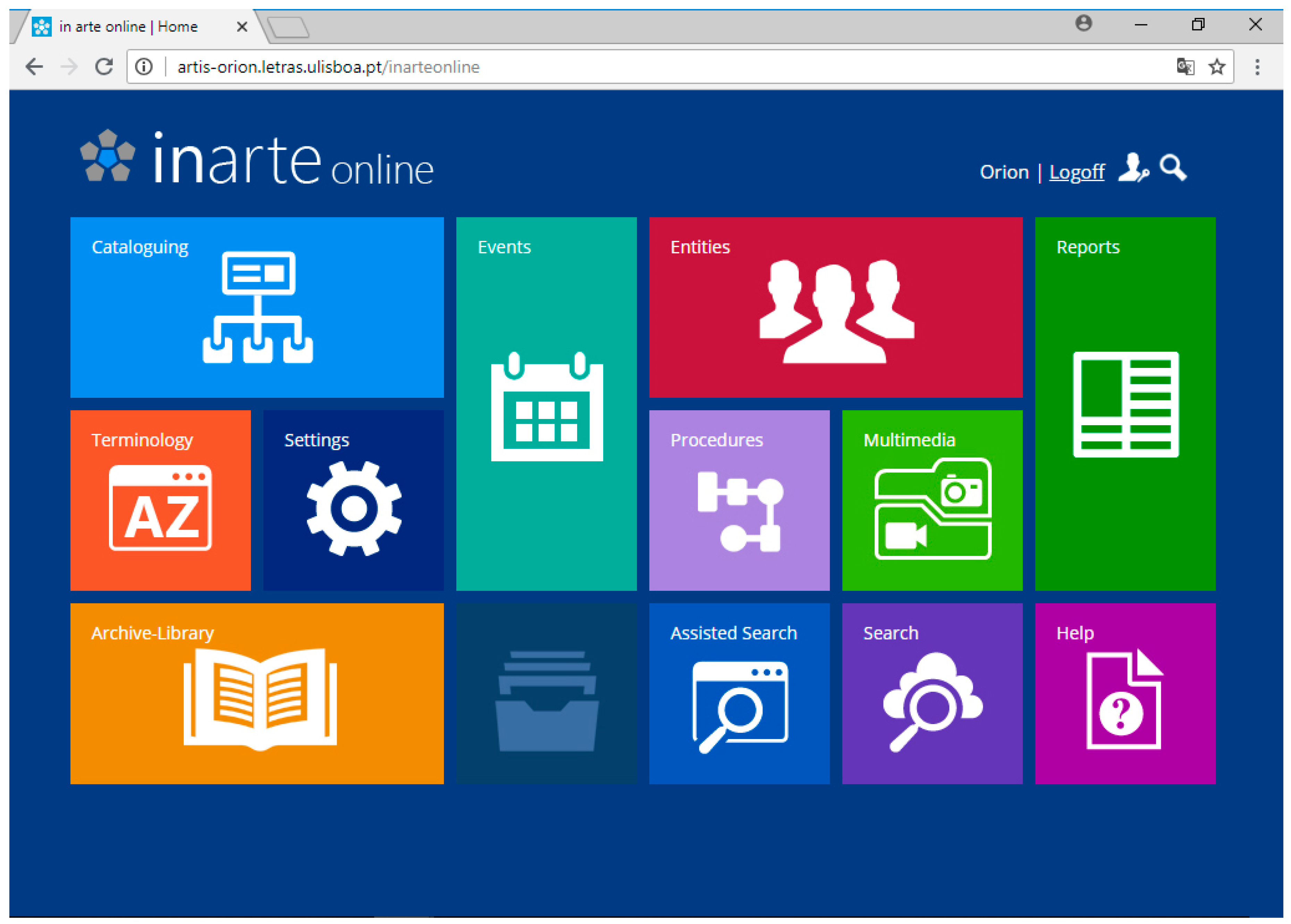
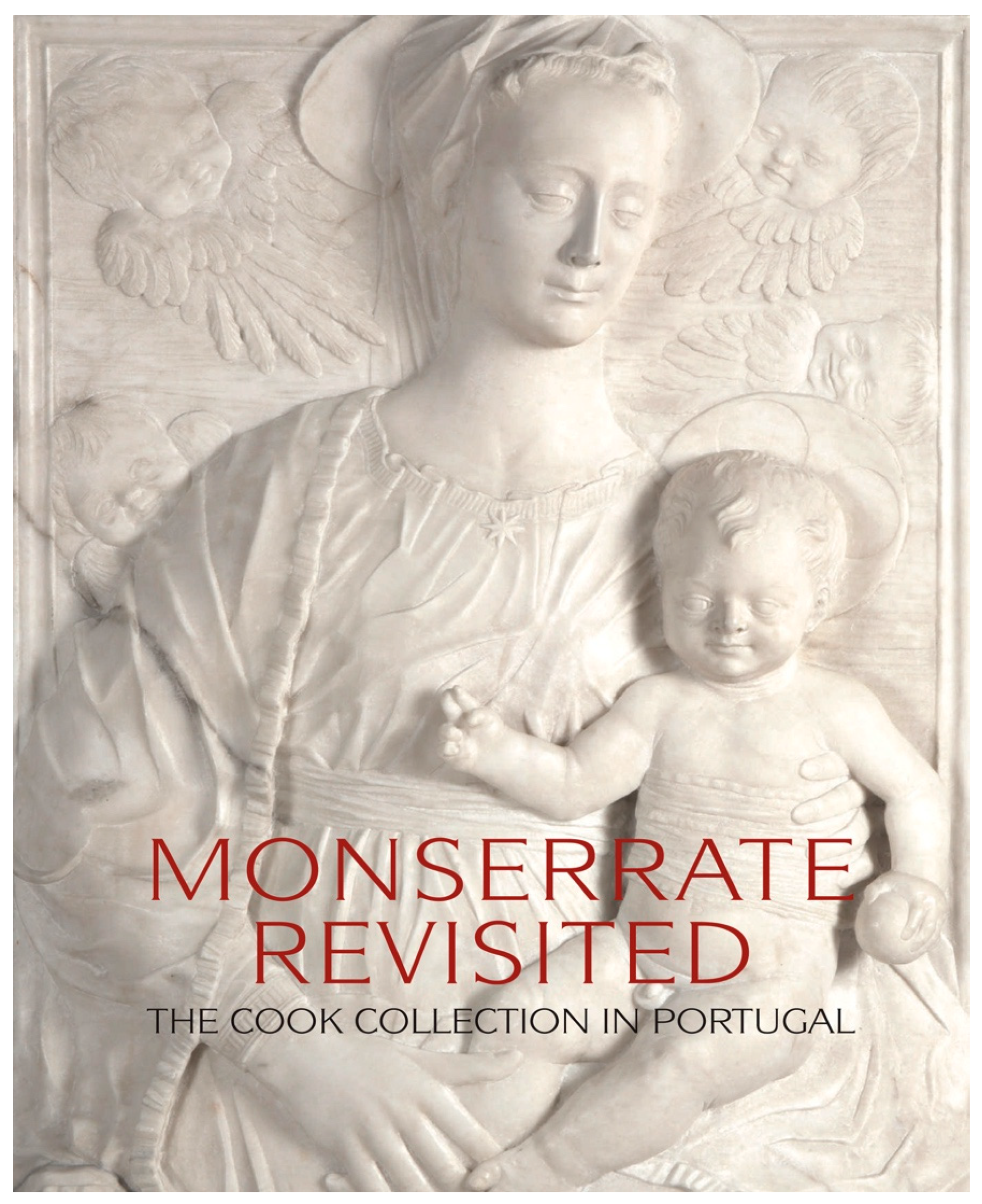
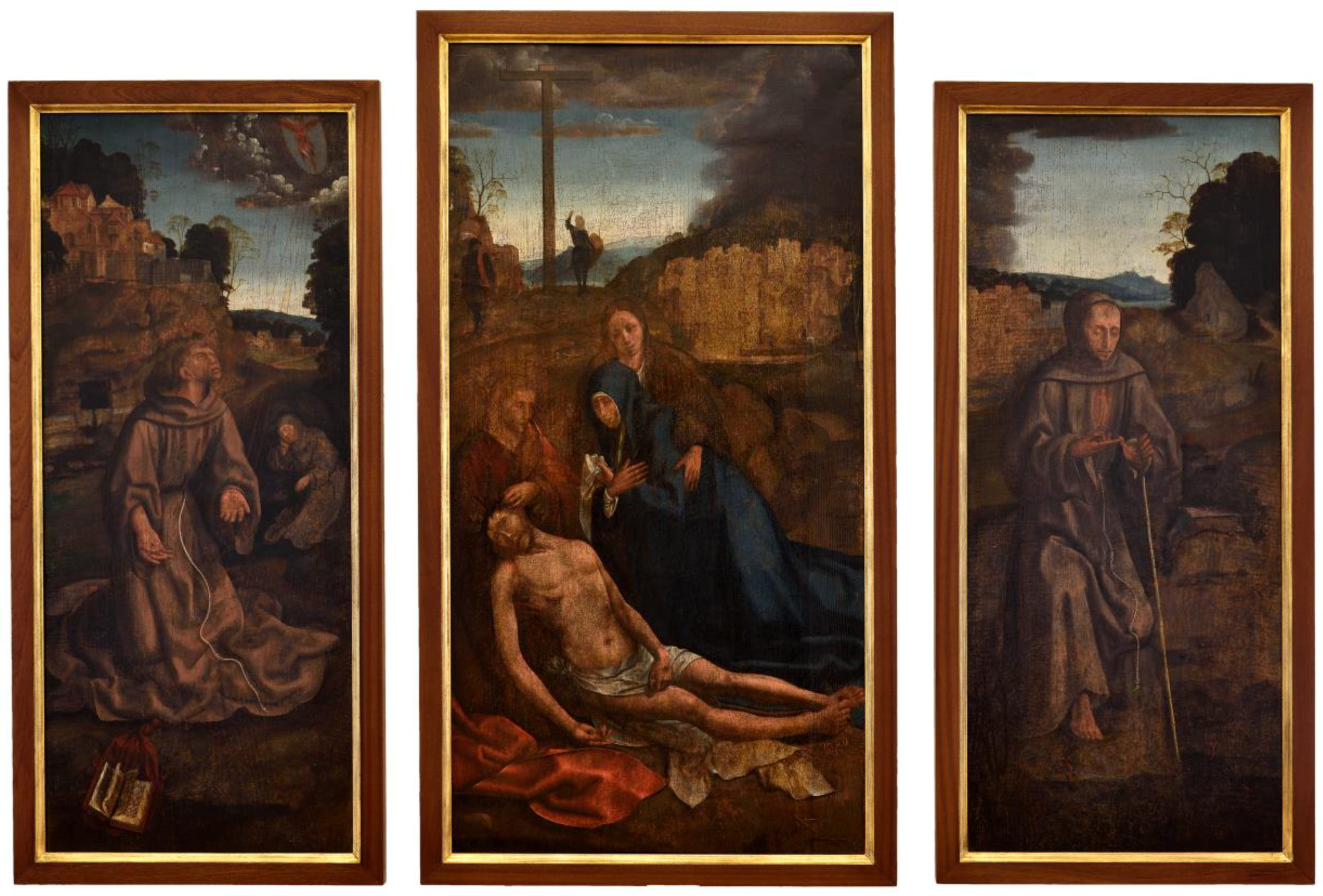
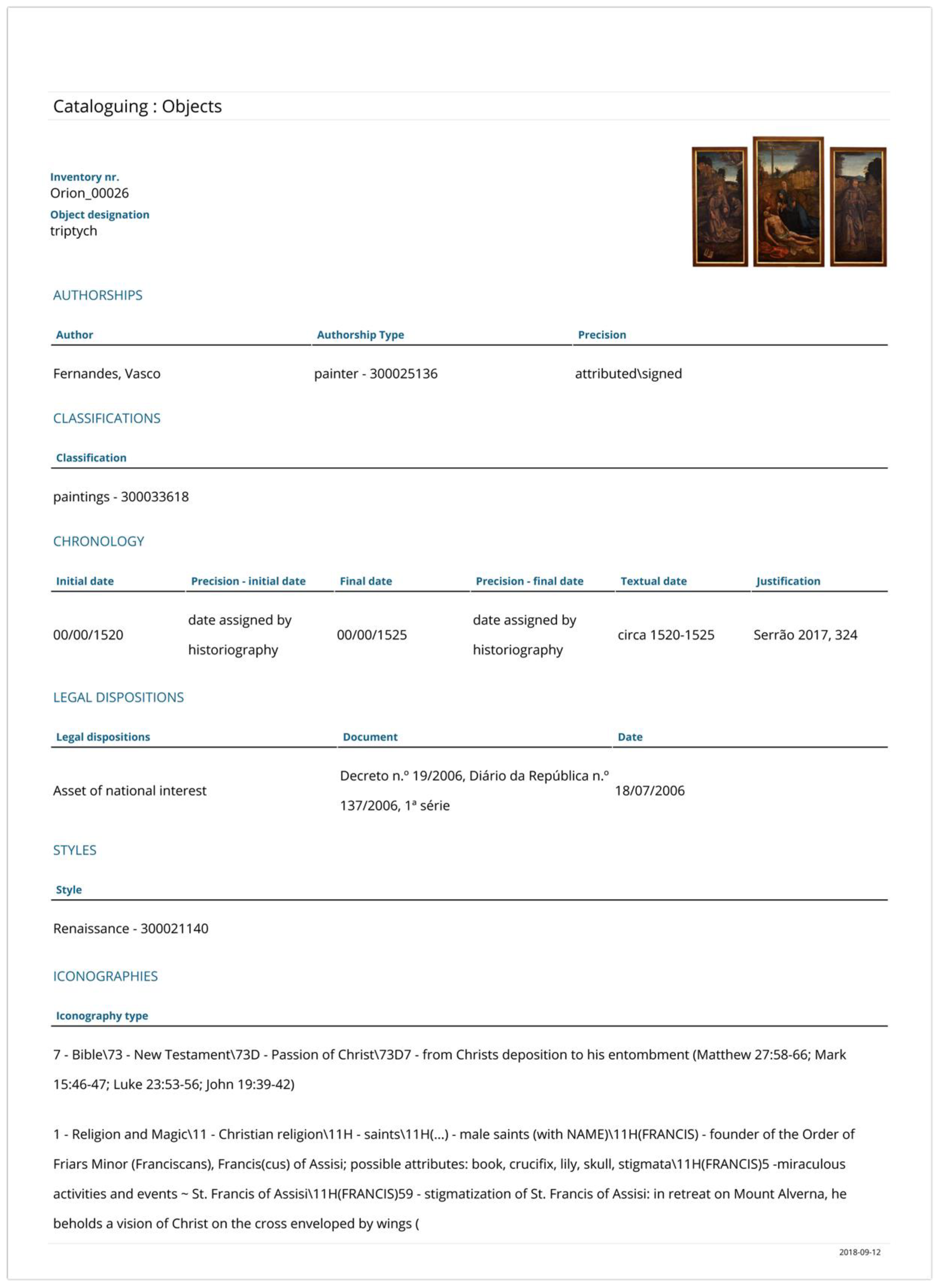
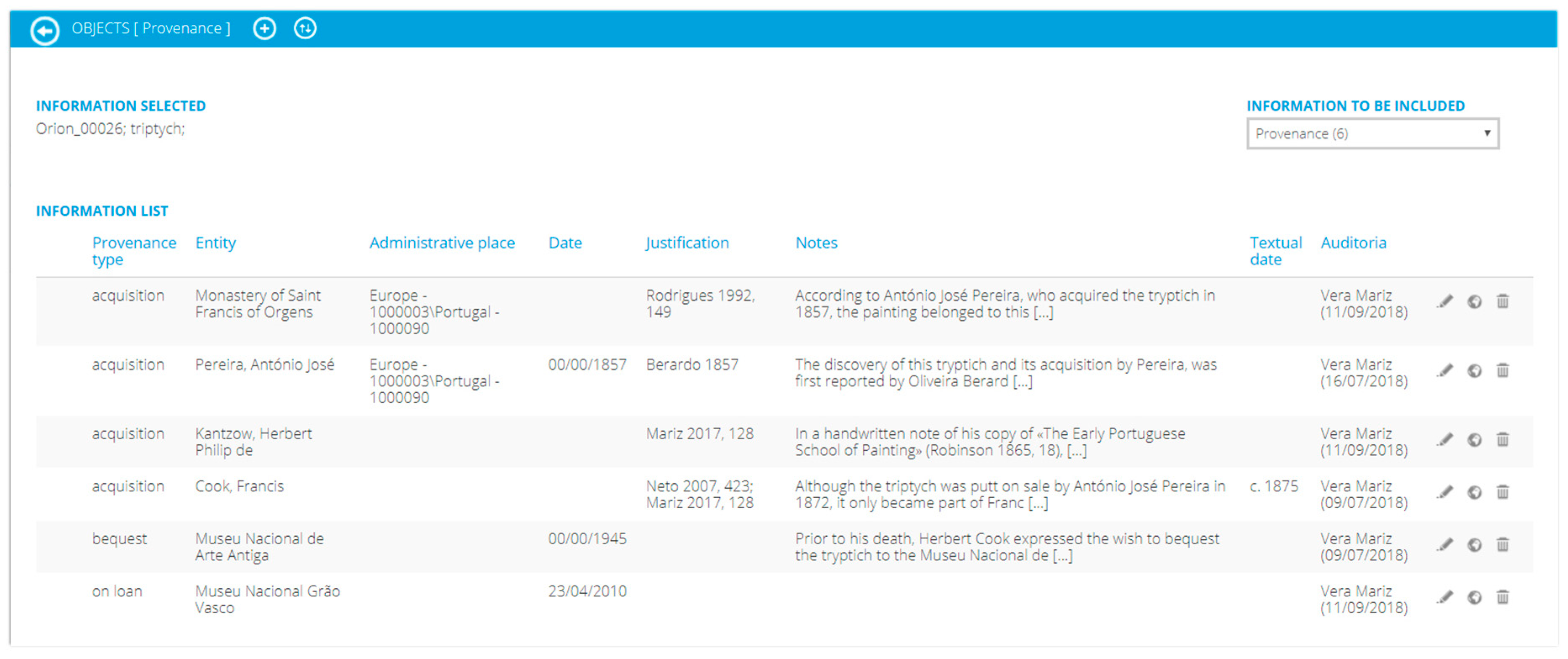
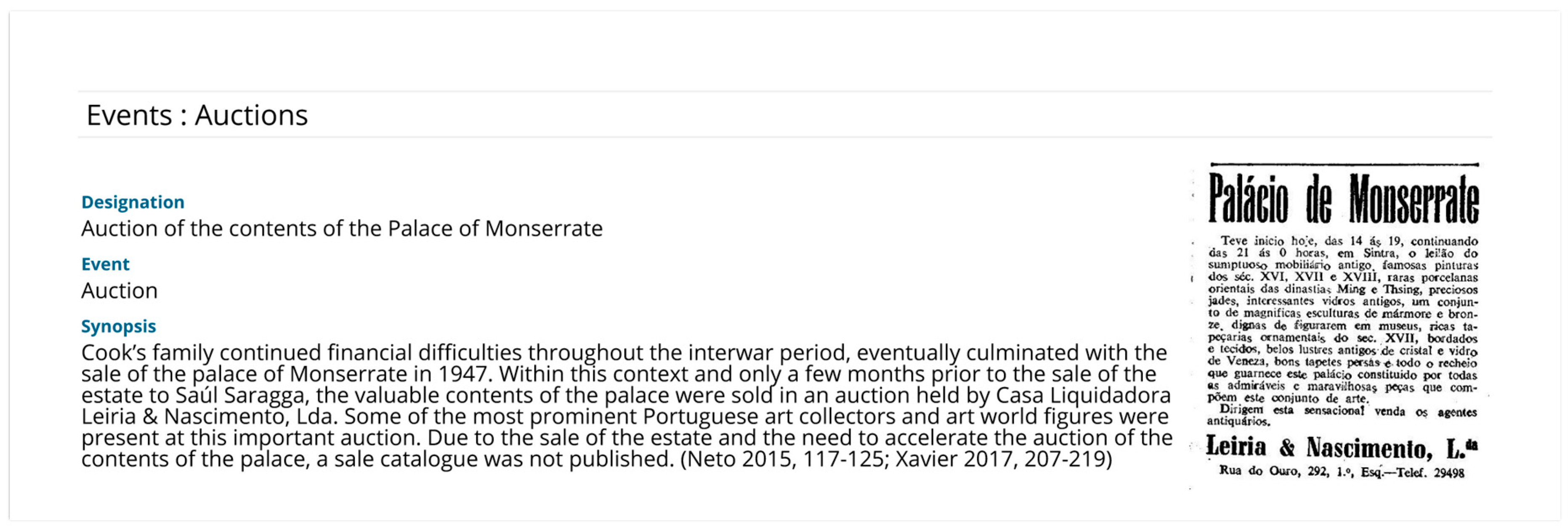
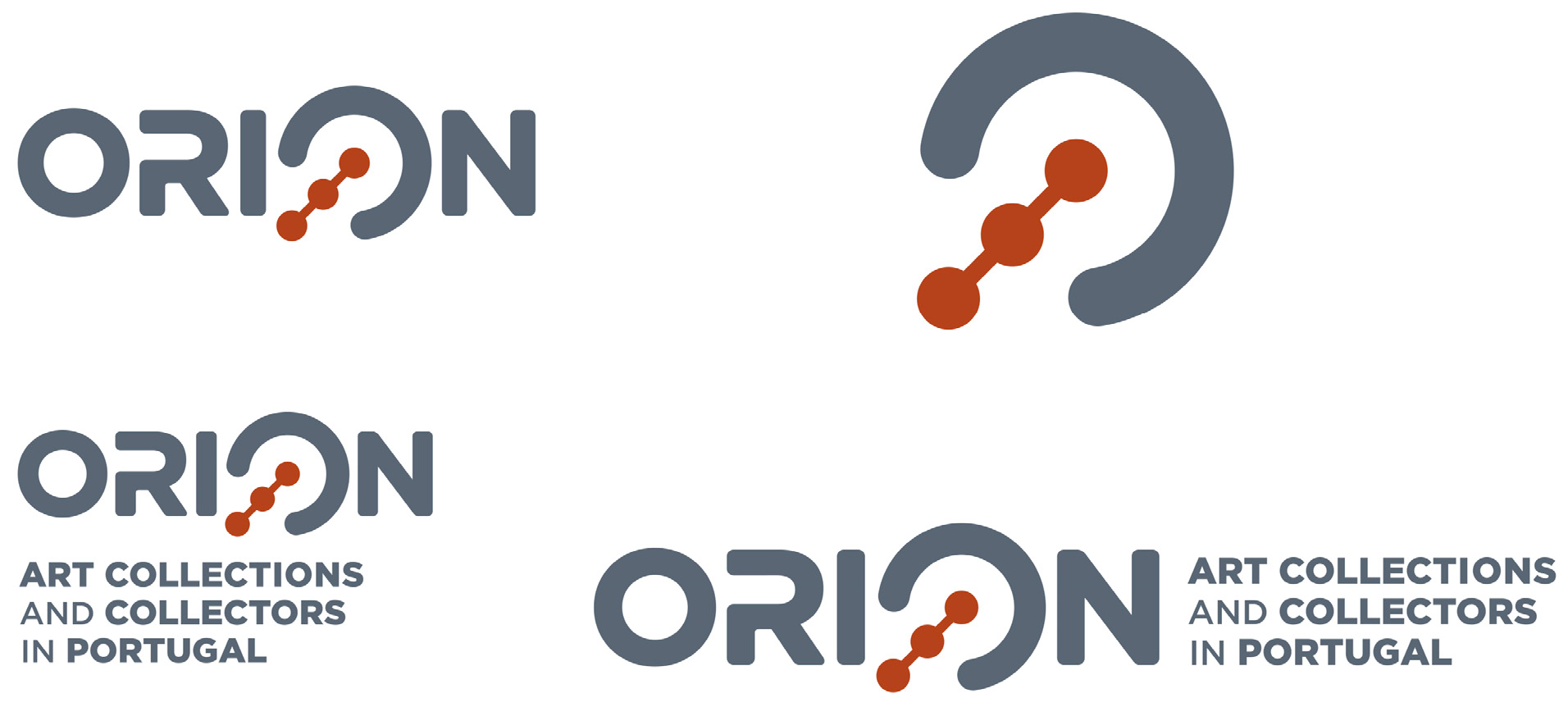
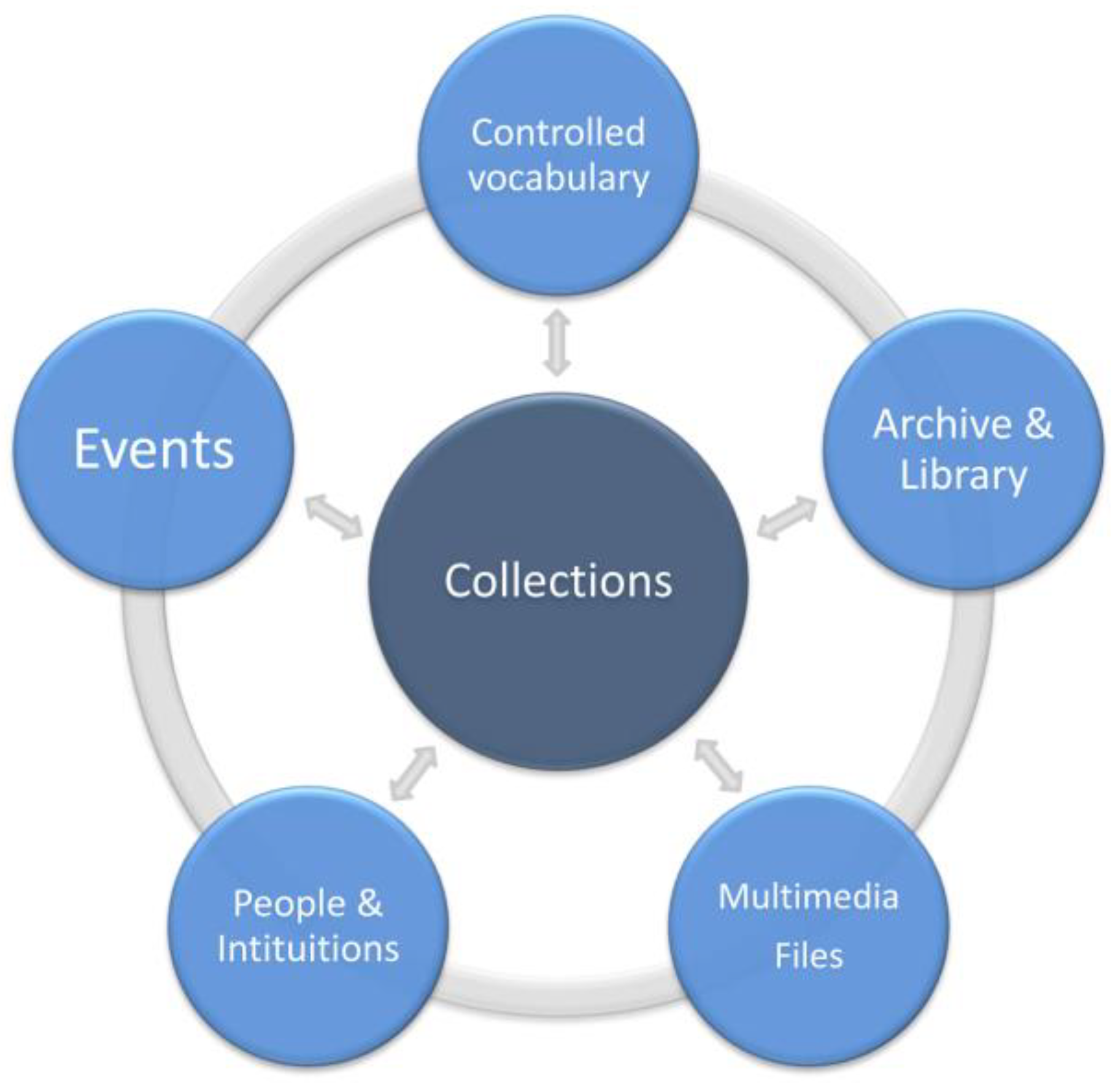
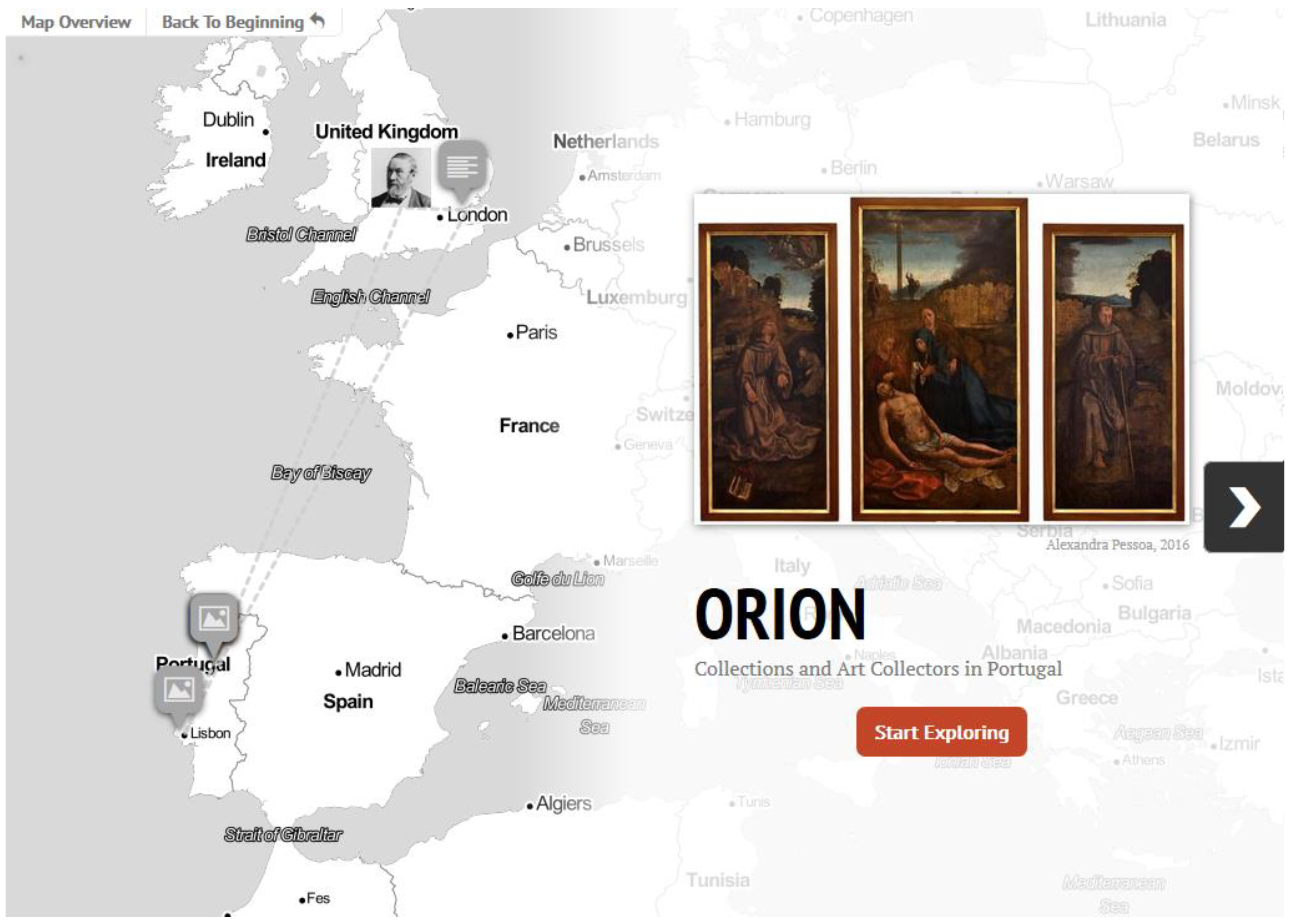
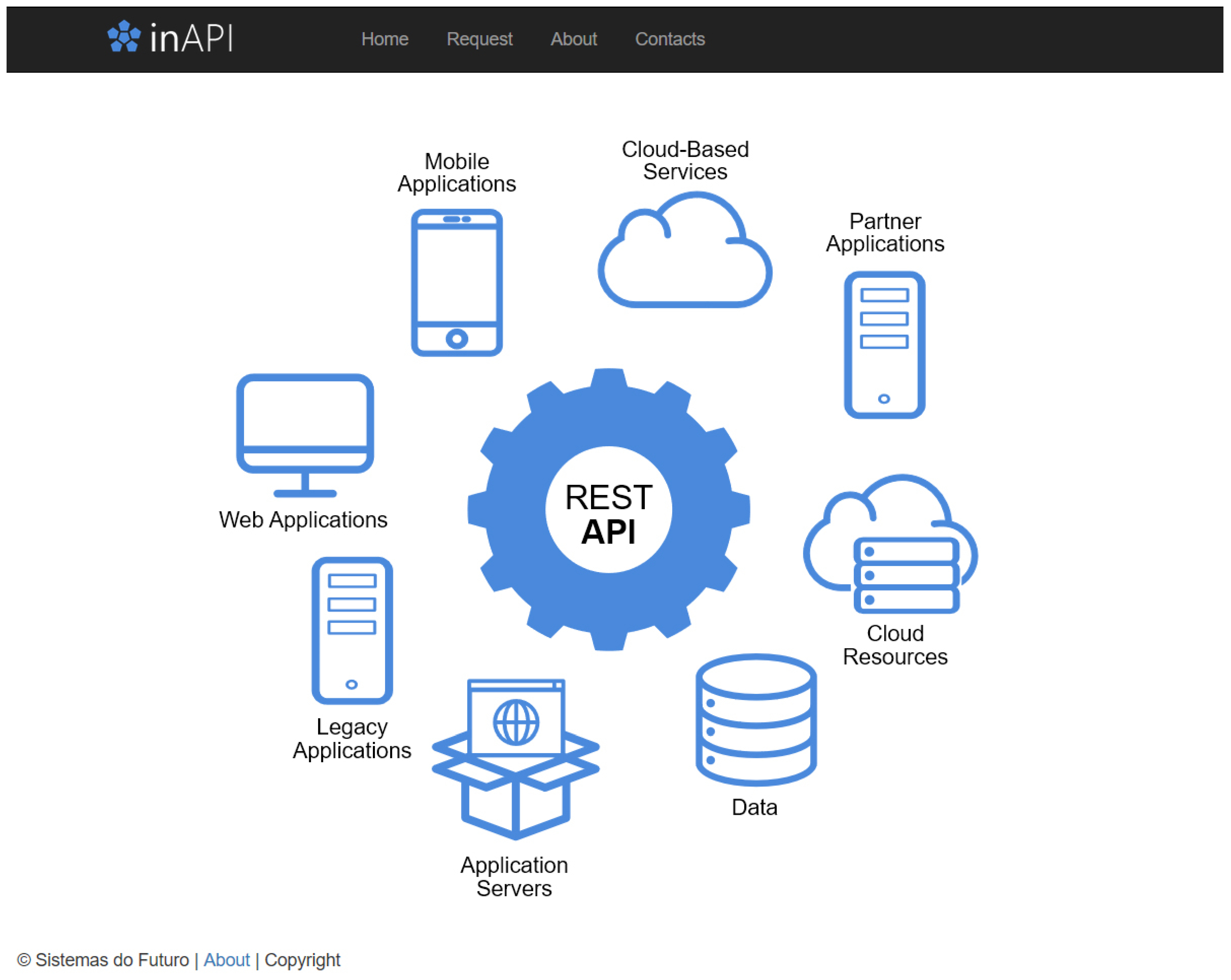
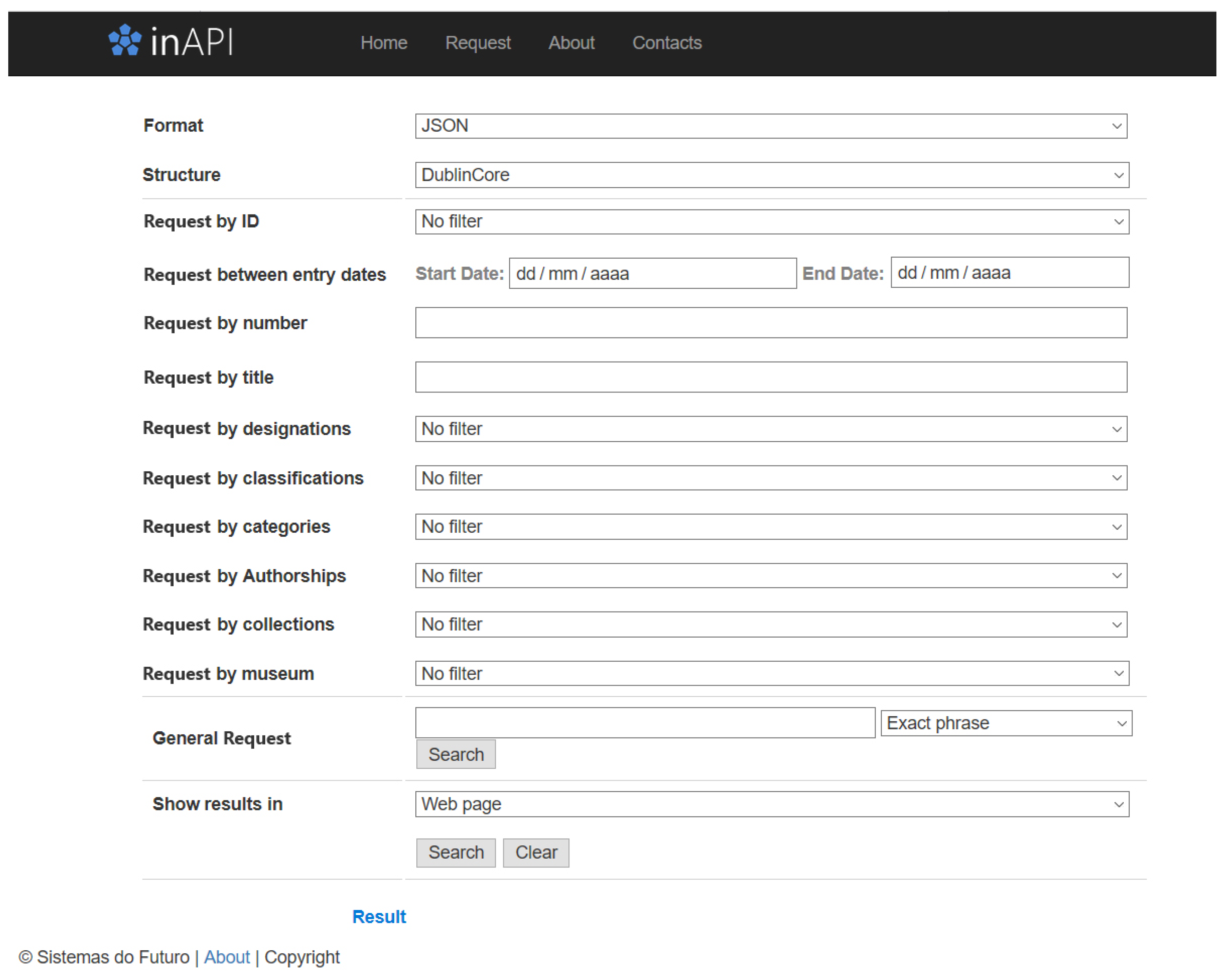
© 2019 by the authors. Licensee MDPI, Basel, Switzerland. This article is an open access article distributed under the terms and conditions of the Creative Commons Attribution (CC BY) license (http://creativecommons.org/licenses/by/4.0/).
Share and Cite
Mariz, V.; Salema de Carvalho, R.; Cabral, F.; Neto, M.J.; Moura Soares, C.; Jorge, N. ORION—Art Collections and Collectors in Portugal. Heritage 2019, 2, 1045-1059. https://doi.org/10.3390/heritage2020068
Mariz V, Salema de Carvalho R, Cabral F, Neto MJ, Moura Soares C, Jorge N. ORION—Art Collections and Collectors in Portugal. Heritage. 2019; 2(2):1045-1059. https://doi.org/10.3390/heritage2020068
Chicago/Turabian StyleMariz, Vera, Rosário Salema de Carvalho, Fernando Cabral, Maria João Neto, Clara Moura Soares, and Natália Jorge. 2019. "ORION—Art Collections and Collectors in Portugal" Heritage 2, no. 2: 1045-1059. https://doi.org/10.3390/heritage2020068
APA StyleMariz, V., Salema de Carvalho, R., Cabral, F., Neto, M. J., Moura Soares, C., & Jorge, N. (2019). ORION—Art Collections and Collectors in Portugal. Heritage, 2(2), 1045-1059. https://doi.org/10.3390/heritage2020068





